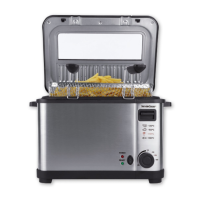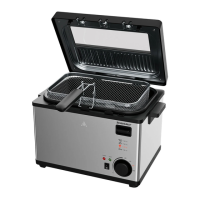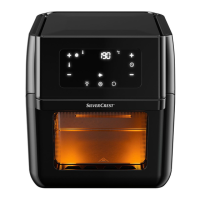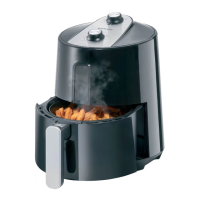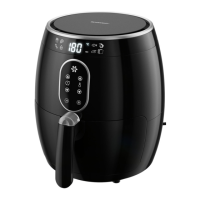9
GB
Which types of oil and fat are
suitable?
There is a wide range of different types of
fat. But not all types of fat and oil are suita-
ble for frying.
• For this fryer, we recommend to use liq-
uid frying oil. If you would like to use
solid frying fat, you should first melt it
slowly in a pan at a low temperature
and then pour it into the fryer. By doing
so, you prevent the device from over-
heating and the fat from splashing.
• The fat or oil must tolerate high tempera-
tures during frying. Be careful that the
fat/oil may be heated at least up to
200 °C.
• The fats should have only a very low
water content. The water evaporates
when heated, and the fat starts spatter-
ing.
• Oils, which are rich in polyunsaturated
fatty acids, are very healthy when used
in salads, but they are not suitable for
frying, because they do not have the
thermal stability required.
• Butter, margarine, and olive oil are not
suitable.
• Coconut oil or palm oil, for example,
are very suitable.
• Different types of fat or oil should never
be mixed!
Storage of used oil
• Any contamination of the fat caused by
frying reduces its shelf life. In order to
remove any coarse dirt, pour the melted
fat through a sieve covered with a pa-
per towel after each frying process be-
fore storing the fat.
• Light and oxygen are harmful to the fat.
Therefore it should be stored in a tightly
closed container in a dark, cool, and
dry place.
• Under proper conditions, the fat can be
stored for a few weeks.
Frying table
Getting rid of unwanted flavours
from the oil/fat
Some food, e.g. fish, loses liquid during fry-
ing. The liquid gets into the oil/fat and alters
its smell and flavour. This flavour will then be
passed on to the next food which is going to
be fried in this oil/fat.
With a simple trick, you can reduce or even
completely remove such unwanted flavours.
1. Heat the oil/fat up to a temperature of
approx. 150 °C.
2. Put 2 thin slices of bread or a bit of
parsley into the frying basket.
3. Put the frying basket into the fryer and
close the lid.
4. Wait until the oil/fat no longer forms
bubbles and then take the frying basket
out of the fryer. The oil/fat should now
have its own flavour again.
Food
Tempera-
ture
(approx.)
Time
(minutes)
Vegetables 130 °C 5-8
Chicken legs 170 °C 15-25
Chicken wings 170 °C 7-15
Chicken breast
fillet
170 °C 8-18
French-fried pota-
toes (fresh)
170 °C 10-15
French-fried pota-
toes (deep-frozen)
according to the manu-
facturer's specifications
Pork cutlet,
breaded
170 °C 15-25
Fish fillet (deep-
frozen)
190 °C 7-15
B53B)ULWWHXVHB%ERRN6HLWH0LWWZRFK$XJXVW
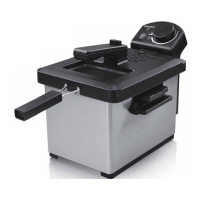
